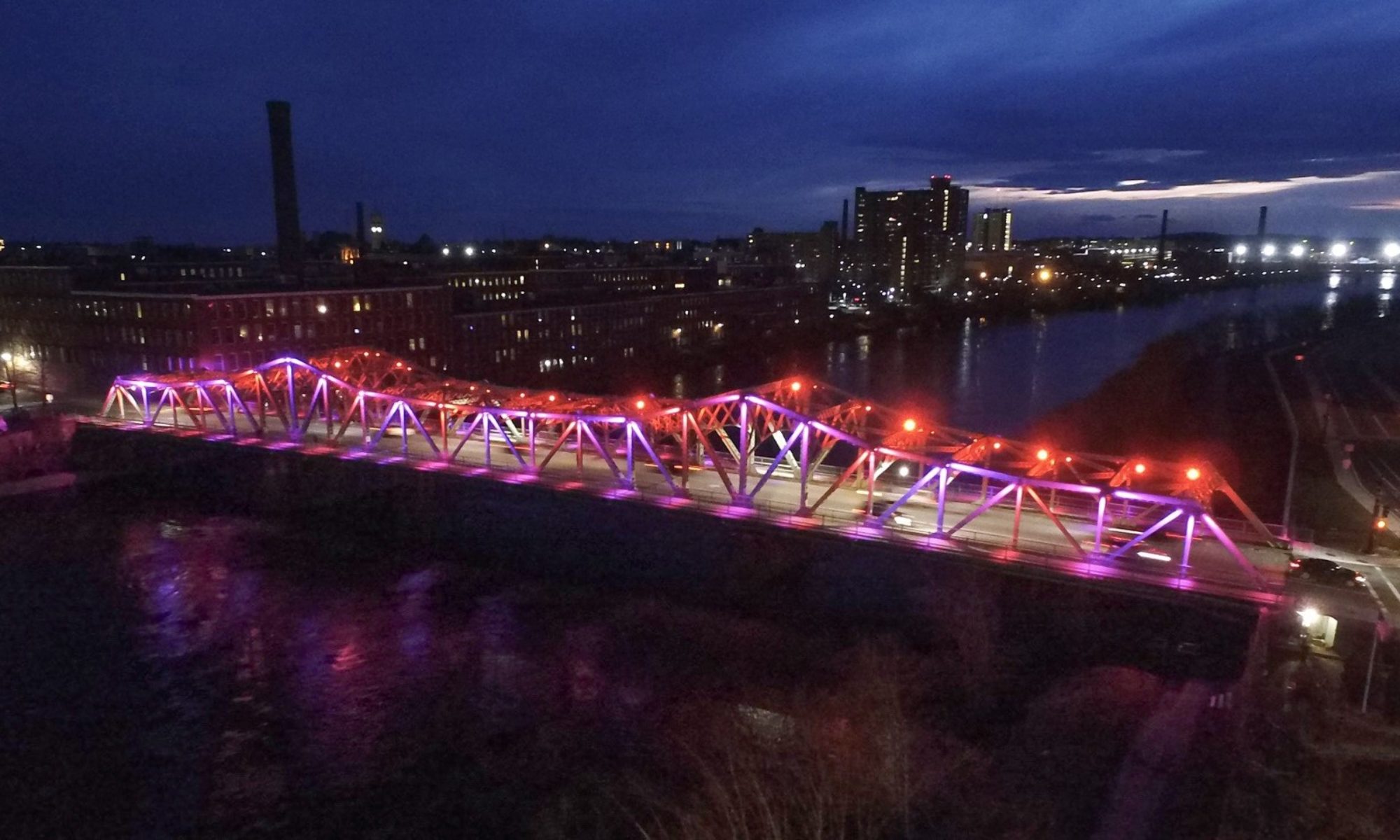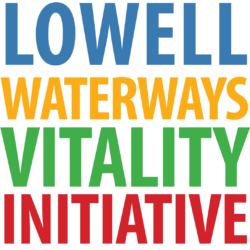Thanks to everyone who joined us at Advancing Our Shared Vision, brightening a dreary Saturday morning with history and exciting ideas for Lower Locks and the other special places on Lowell’s waterways.
Our next step is to form working groups for actions we brainstormed in our discussion. If you would like to help or if you have thoughts on any of our topics, please reply to this email. We know our tour went a little long, so if you missed the discussion, we still want to hear from you! We’re collecting as much input as possible as we chart our course for 2019 and will have additional meet-ups and group discussions moving forward.

Our Tour
Andrew Shapiro started off the tour by pointing out the connections between the Hamilton Canal Innovation District and downtown, mentioning a number of high-profile projects being built in the area.

David Byers then explored the history of Lower Locks, explaining that the confluence of the Merrimack and Concord has been a gathering place for thousands of years. For example, Wamesit, one of two native settlements that existed in the Lowell area when Europeans arrived, was east of the Concord. The current UMass Inn & Conference Center was the site of the first major textile factory on the Concord. Finally, the Pawtucket Canal is flanked by two of the oldest buildings still standing in Lowell. One of which, the current Lowell Academy Hairstyling Institute, was once Frye’s Tavern, then the American Hotel. This was the meeting place for mill agent Kirk Boott and Irish immigrant Hugh Cummiskey, when they discussed hiring Irish workers to construct the canals.

Jane Calvin talked about the Lowell Parks & Conservation Trust’s current efforts. Lower Locks is central to many of them: counting fish that swim from the ocean to the Concord via the Merrimack; conducting whitewater river rafting trips down the Concord; and completing the Concord River Greenway, creating a crossroad of trails including the Merrimack Riverwalk and a riverside trail through Belvidere toward Lawrence. Rafting trips used to utilize the lock chambers, but those chambers are now in need of repair.
Steve Ramirez, owner of Blue Taleh, showed the inside of the newly-renovated first floor of the former Sun printing press. A former worker recalled how the area was used as a loading bay, putting newspapers on trucks. Mr. Ramriez will now begin marketing the space, hoping for a restaurant or entertainment use, with a plan to enliven the canalwalk with people. However, he intends to be respectful of the residents living above the space, and isn’t looking for loud clubs or rowdy businesses.

Finally, architect Dan Adams, designer of the Cox (Bridge Street) Bridge lighting, discussed how Lowell is special. Everyone that worked on the lighting project, from metal fabricators to electricians, were from Lowell—the first time he’s seen that in a community. Not only does Lowell have many skills to leverage, it is famous in architectural circles. Mr. Adams said Lowell is required reading for architecture students.
Discussion
We broke our discussion into four topics, brainstorming short, medium, and long-term actions for each! This email contains just a sample of the ideas we discussed, and the full notes are available here:
https://drive.google.com/file/d/1I2ROdt3z1daLkqYFKI-cLG8msMjXKiJx/view?usp=sharing
Arts and Performing Arts
A number of visual and performing artists participated in the discussion and believed that arts were a key way to engage young people, attract college-aged folks, and even bring in people from outside of Lowell to appreciate our waterways. The diverse group suggested for all actions to Involve ethnic and cultural organizations to find out how people want to show off their culture.
Short Term: Have a waterside talent show and art showcase with prizes focused on young arts
Medium Term: Create a participatory light art performance with handheld lamps that audience can use
Long Term: Create a movable theatre for “brunch theatre” and food trucks at the focus areas
Water Access
This discussion centered around the ways we can start working together with the three entities (National Park Service, the Massachusetts Department of Conservation and Recreation, and Enel Green Power) that have ownership or rights in the canals to launch kayaks, paddleboats, or kinetic sculptures safely in the canal. Enel is advancing a study to be completed in 2020 that will identify locations and improvements needed for these recreational uses as part of its relicensing process, and the comment period for that relicensing is open.
Short Term: The Public is encouraged to comment on the FERC relicensing process
Medium Term: Explore a demonstration project such as a Folk Festival gondola fundraiser with Enel, NPS, and DCR
Long Term: Utilize Enel studies to locate a safe, lengthy kayak run, perhaps on Western Canal, with associated improvements to be able to launch the kayaks and ensure the safety of those in the canal
Improving Lower Locks
Waterways intends to work with its partners to develop a major improvement project to repair the plaza and lock chambers of Lower Locks, including improving the plaza’s accessibility, utility, and appearance. This conversation centered on what to include in that project and small actions that could be done before the project.
Short Term: Abutters used to put a lit holiday tree on the small island in the canal. They’re interested in renewing the tradition
Medium Term: Improve the gateways of the plaza, including directory signage and lighting in the “Clafin Block” tunnel and bridge between Middlesex Community College and Prescott Street
Long Term: Make an arts/technology walk as part of the retrofit, including possible lighting in the walkway and improvements to the pavement surface of plaza
Economic Development
The economic development group included discussion of both general economic development and how a festival might be able to strengthen economic development. The festival was the subject of a great deal of discussion, including where and when it would happen, or even if a small weekly waterside event with different sponsors would be better than one, large festival.
Short Term: Enlist a pilot coffee cart or beer/wine garden in Lower Locks area
Medium Term: Promote Kerouac Park incubator for existing businesses
Long Term: Locate an underutilized waterside storefront to have a rotating restaurant similar to Lawrence’s Revolving Test Kitchen
Final Thoughts
Thanks again to everyone who came out. We had a number of questions about the food, so here it is, all in downtown Lowell:
- Subs, including falafel, tikka chicken, and more: Pizza and Sub Stop
- Quesadillas and Dominican fare: Time Out Cafe
- Dessert Waffles: Sweet Journey
Special thanks to Middlesex Community College and Steve Ramirez for hosting, City of Lowell for poster printing, all of our tour guides, Lowell National Historical Park for attending and providing a glimpse into the Gatehouse, Fred Faust for photos, and the Steering Committee and Lowell Heritage Partnership for spearheading the Lowell Waterways coalition.
Remember, if you want to join a conversation about any of the above ideas or want to send us your thoughts in writing, please reply to this email!

